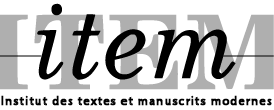Sous la co-direction de
Irène FENOGLIO, Directrice de Recherches – Institut des Textes et Manuscrits Modernes CNRS/ENS – Paris, France et Riikka ALANEN, Professor – Department of Applied Linguistic University of Jyväskyla – Jyväskylä, Finlande
Soutenance le samedi 12 novembre 2011 – Université de Jyväskylä
style= »text-align:justify; »>
Supervisors : Riika Alanen (University of Jyväskylä), Irène Fenoglio (CNRS, ITEM, Paris), Seppo Tella (University of Helsinki)
Reviewers : Denis Alamargot (Université de Poitiers), Céline Beaudet (Université Sherbrooke, Quebec)
Opponent : Sylvie Plane (Université Paris-Sorbonne)
ABSTRACT
Leblay Christophe, Le temps de l’écriture. Genèse, durée, représentations
This work focuses on writing as a process describable, registering in time and space, rather than the text. This choice is based on the theoretical and methodological assumption, that, contrary to what one might expect, the product is not the true picture of the production: seeking to understand the writing process from the product would be an illusion. By adopting a genetic approach to the text associated with recording software for writing, so-called keystroke-logging software, this work tries to put the writing subject in the foreground of writing and gives each apprentice editor understanding within his/her own activity as a writer. This work is structured around five publications that provide some answers to 9 questions, divided into three themes: (1) transactions that underpin the development of the text [Genesis], (2) temporality that characterizes the Writing [Time] and (3) the impact of the representations of this temporal learning of writing [Representations]. The aim is to demonstrate that the temporality, a dimension substantial of writing (in addition to the spatiality), may be a relevant educational input, taking advantage of new ways of writing and appropriate digital representations. It’s about understanding the temporality of the writing operations during rewriting i.e. revision from two different corpus, representing two complementary technologies, one on paper and one on screen. Methodology, rooted in genetic criticism, includes contributions from other disciplines such as cognitive psychology, linguistics of writing and the teaching of writing. Much of the work consists in exploring the intersection of disciplines, analyzing the respective contributions of multidisciplinarity, interdisciplinarity and transdisciplinarity. A comparison of terms and concepts is conducted, and as well a discussion of the relevance of different modes of representation of temporality. It is in this context that is described and exemplified a new way of viewing writing process based on an adaptation of mathematical graph theory.

















